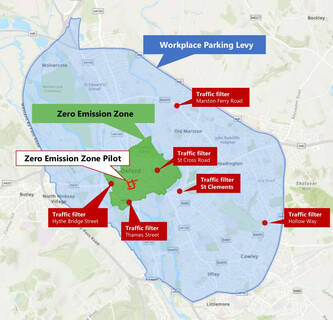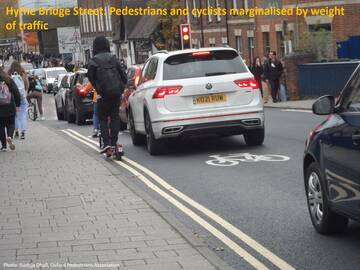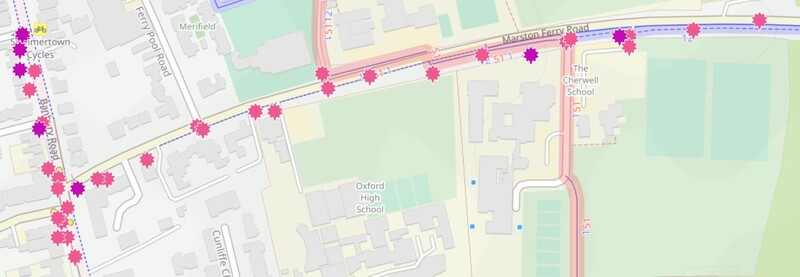How should the planned Oxford traffic filters work: what hours should they operate, what exemptions should there be, and so forth? To understand this, we need to understand their purposes:
- to allow space and time to be reallocated to make walking and cycling safe and accessible, especially at junctions
- to stop buses being congested and delayed, to have better and more efficient bus services
- to free up space (and reduce noise and air pollution) for an improved public realm
But while the goals may be the same, the unique geography of each filter — and the very different roads they are on — means that they may need quite different implementations. This can be illustrated by Hythe Bridge St and Marston Ferry Rd.
Hythe Bridge St
The Hythe Bridge St traffic filter needs to operate 24 hours, with exemptions only for emergency vehicles. This is necessary to enable it as a safe and accessible walking and cycling route.
There are no buses on Hythe Bridge St, but the filter there will decongest buses using Frideswide Square and St Giles. The other major concerns are that Hythe Bridge St currently has pavements that are way too narrow for its high volumes of pedestrian traffic, and that it forces people cycling to mix with motor traffic. It is the key route connecting west Oxford to the city centre (and the railway station to the bus station).
The bridge itself is 9.5m wide. There is no way to support two-way motor traffic and provide adequate pavements, let alone space for cycling. Removal of motor traffic will allow 2.75m footways on either side and a 4m wide bi-directional cycle track in the middle, the latter usable by emergency vehicles. Taxis can use Park End St, which will continue to provide access to the Worcester St car park and to New Inn Hall St and other streets.
East-West cycle traffic on Hythe Bridge-George would then cross bus and taxi (and some cycle) traffic on Worcester St at a simple cross junction.
Marston Ferry Rd
With fewer constraints, the Marston Ferry Rd filter can operate just in peak hour periods and have exemptions even then.
With fully separated cycle tracks and footpaths for most of its length, Marston Ferry Rd raises road safety concerns only at the western end, at the junction with Banbury Rd and access to the leisure centre and school, and where the track along the east bank of the Cherwell crosses (this will be more heavily used following housing developments at Mill Lane).
The key goals here are:
- reducing traffic in peak hour so the buses move freely
- reducing peak traffic volumes enough to allow the western end of Marston Ferry Rd and its junction with Banbury Rd to be redesigned for safe and accessible walking and cycling — which will probably involve removing the separate turning lanes on all three approaches.
These goals can be achieved by peak hour restrictions that stop commuter traffic, with exemptions for taxis, blue badge holders, etc.




This all makes sense to me, with the proviso that peak hours on Marston Ferry Road will be much longer once there's a full traffic filter on Longwall Street, since it's the next obvious detour for cars taking that route. With current traffic the filter would probably have to be 7-10am and 3-7pm at minimum. Under Connecting Oxford it might end up needing similar hours to the High Street bus gates in order to be effective. Here's hoping!
That's a good point Sophia. And the filters can't just operate in current peak hour, as they'll displace traffic to just before they start and just after they stop. So maybe MFR needs to be 7am-7pm like the others. (From the briefing I went to, officers seem to be assuming all gates will be 7 to 7 as a default.)
Ah, that's interesting news, I didn't realise that 7 to 7 was the assumption!
That would be very sensible - I was walking down MFR at noon today, thinking about this question, and there was actually plenty of traffic then too.
The traffic congestion on Marston Ferry Road could be much reduced by simply changing the timing on the lights at the junction with Banbury Rd, or by making Moreton Road one way, away from the junction - to make it easier for traffic to get out of MF Rd into Banbury Rd. Moreton Road traffic has priority and so, even at quite quiet times of day, if there are several cars turning left out of Moreton Rd, no cars can get out of MF Rd to turn right up Banbury Rd - leading to queues of idling cars and associated pollution.
Junction West end Marston Ferry Road with Banbury Road is often fouled up as bus stops are too close to the ruction going east down MFR of north up BR or the stops should be widened to allow bus to stop clear of carriageway. T'other end of MFR at the lights with B4150 by the BP garage the junction is badly laid out and the lights not well timed so there needs to be a longer designated filter left lane with a filter left on the traffic light from the extended MFR into the B4150 otherwise traffic is often trapped and cannot exit Oxford if there is congestion t'other she of same lights.
As a frequent visitor to Oxford it seems the main priority should be extending the wonderful Marston Ferry grade segregated cycle track all the way to Banbury Road.
This last 200 meters would need a determined push from planning. The clear benefits would be connecting up active travel routes. Make this more about non-stop interconnected active travel design.
As a supermarket delivery driver, often providing an essential service to the less mobile members of our community
How are these further restrictions going to lmpact us ? The job is becoming increasingly difficult with so many road restrictions
Coming into play. How about including us along with the taxi drivers for some sort of exemption??
The current proposals for the traffic filters would exempt all vans, so delivery drivers shouldn't be affected - indeed, they should enjoy much faster trips through the city centre.